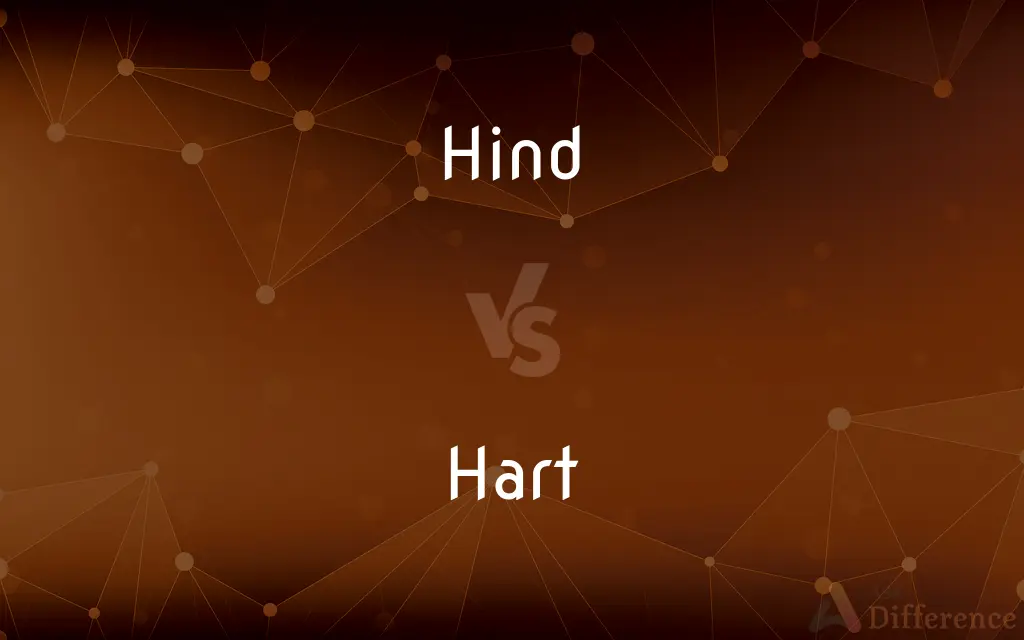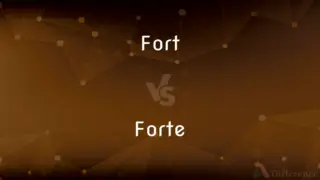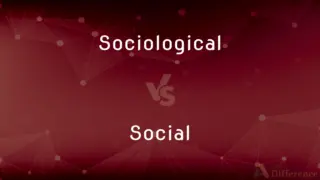Hind vs. Hart — What's the Difference?
By Maham Liaqat & Urooj Arif — Updated on April 27, 2024
A hind is a female red deer, especially after her first year, while a hart is an adult male red deer.

Difference Between Hind and Hart
Table of Contents
ADVERTISEMENT
Key Differences
A hind is the term used for a female red deer, typically after its first year, emphasizing the gender-specific terminology in animal classification. On the other hand, a hart refers specifically to an adult male red deer, showcasing a parallel in nomenclature that highlights maturity and gender.
While hinds are generally smaller and less conspicuous than their male counterparts, focusing on raising fawns and often moving in groups for safety, harts are notable for their larger size and the impressive antlers they develop, which are used in territorial fights during the mating season.
The behavior of hinds is characterized by more cautious and collective living, which helps protect their young and ensure their survival. Conversely, harts tend to be more solitary or live in bachelor groups outside of the breeding season and are known for their more aggressive behavior during the rut.
In terms of habitat usage, hinds require areas that provide ample cover and foraging options to support their needs and those of their fawns, whereas harts may roam more widely, seeking out the best territories that can offer optimal resources for attracting females during the rut.
The roles of hinds and harts in the ecosystem are also quite distinct. Hinds play a crucial role in the dynamics of deer populations, primarily through their capacity for reproduction and rearing of young. Meanwhile, harts contribute by competing for dominance, which can influence genetic diversity and the health of the population through natural selection.
ADVERTISEMENT
Comparison Chart
Gender
Female
Male
Size
Smaller, less conspicuous
Larger, with prominent antlers
Social Behavior
Moves in groups, cautious
More solitary or in bachelor groups
Role during mating season
Rearing young
Competing for females
Contribution to ecosystem
Population maintenance
Genetic diversity, population health
Compare with Definitions
Hind
Often used more broadly to refer to any female deer.
The hind stood alert at the edge of the clearing.
Hart
Can sometimes be used to refer to any male deer in poetic or archaic usage.
A young hart wandered into the garden at dawn.
Hind
In historical contexts, refers to a peasant or farm laborer.
In medieval times, a hind might work the lands of a feudal lord.
Hart
Historically used in royal hunting terminology.
The king's party pursued the hart through the forest.
Hind
In nautical terms, refers to the rear part of a ship.
The storm damaged the hind section of the ship severely.
Hart
Symbolic in various cultures, representing virility and natural forces.
The hart is often depicted in coats of arms.
Hind
A female red deer, especially one over one year old.
The hind carefully guided her fawns through the dense forest.
Hart
In literature, represents nobility or a formidable opponent.
The hero faced the hart, a creature of great lore.
Hind
As an adjective, refers to being positioned at the back.
The hind legs of the horse are very powerful.
Hart
A male deer, especially a male red deer over five years old.
Hind
Located at or forming the back or rear; posterior
An animal's hind legs.
The hinder part of a steer.
Hart
A male deer, especially the male of the red deer after his fifth year.
Hind
A female red deer.
Hart
A male red deer or one of related species.
Hind
Any of various spotted groupers of the genus Epinephelus or various related fishes of the genus Cephalopholis.
Hart
Obsolete spelling of heart
Hind
Chiefly British A farm laborer, especially a skilled worker.
Hart
A stag; the male of the red deer. See the Note under Buck.
Goodliest of all the forest, hart and hind.
Hind
(Archaic) A country bumpkin; a rustic.
Hart
United States playwright who collaborated with George S. Kaufman (1904-1961)
Hind
Located at the rear (most often said of animals' body parts).
Hart
United States lyricist who collaborated with Richard Rodgers (1895-1943)
Hind
Backward; to the rear.
Hart
Male red deer
Hind
A female deer, especially a red deer at least two years old.
Hind
A spotted food fish of the genus Epinephelus.
Hind
(archaic) A servant, especially an agricultural labourer.
Hind
The female of the red deer, of which the male is the stag.
Hind
A spotted food fish of the genus Epinephelus, as Epinephelus apua of Bermuda, and Epinephelus Drummond-hayi of Florida; - called also coney, John Paw, spotted hind.
Hind
A domestic; a servant.
Hind
A peasant; a rustic; a farm servant.
The hind, that homeward driving the slow steerTells how man's daily work goes forward here.
Hind
In the rear; - opposed to front; of or pertaining to the part or end which follows or is behind, in opposition to the part which leads or is before; as, the hind legs or hind feet of a quadruped; the hind man in a procession.
Hind
Any of several mostly spotted fishes that resemble groupers
Hind
Female red deer
Hind
Located at or near the back of an animal;
Back (or hind) legs
The hinder part of a carcass
Common Curiosities
How do hinds contribute to the deer community?
Hinds are central to raising young and maintaining population numbers through their reproductive roles.
Can the term 'hind' be used for other deer species?
Yes, while it typically refers to red deer, 'hind' can also broadly describe any female deer.
Why are harts significant in deer populations?
Harts play a crucial role in breeding and ensuring genetic diversity through their competitive behaviors during the rut.
Is there a specific age when a male deer becomes a hart?
Yes, a male red deer is typically called a hart when it surpasses five years of age.
What is the historical significance of harts?
Harts have been prominent in royal hunting traditions and are often symbolic in heraldry and literature.
Are hinds involved in the rutting season?
While harts actively compete for mates, hinds are involved by choosing and mating with the dominant males.
How do the antlers of a hart change over time?
Hart antlers grow larger and more complex with age, shedding and regrowing annually.
What is a hind?
A hind is a female red deer, particularly one that is more than one year old.
How do hinds and harts affect their ecosystems differently?
Hinds help stabilize the population by nurturing young, while harts affect the population's health and diversity through dominance challenges.
What is the social structure like for hinds compared to harts?
Hinds often form herds with other females and young, which provides safety and communal care, unlike the more solitary or loosely grouped harts.
What literary roles do harts often play?
In literature, harts are frequently depicted as noble or mystical creatures, symbolizing nature's untamed beauty and strength.
What are the behavioral differences between a hind and a hart?
Hinds are more group-oriented and protective, especially of young, whereas harts are more solitary and competitive.
What adaptations do hinds have for their role?
Hinds have adapted to be more elusive and protective, crucial for successfully rearing fawns.
Share Your Discovery

Previous Comparison
Fort vs. Forte
Next Comparison
Sociological vs. SocialAuthor Spotlight
Written by
Maham LiaqatCo-written by
Urooj ArifUrooj is a skilled content writer at Ask Difference, known for her exceptional ability to simplify complex topics into engaging and informative content. With a passion for research and a flair for clear, concise writing, she consistently delivers articles that resonate with our diverse audience.














































